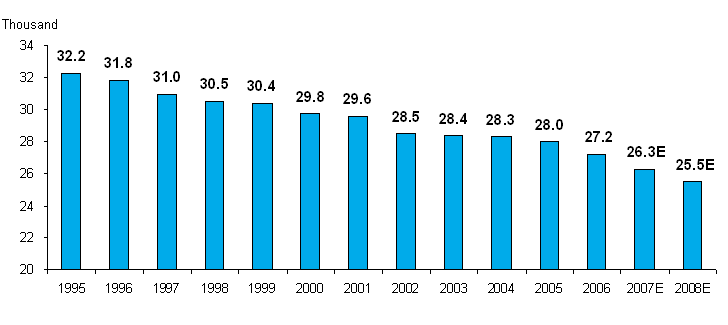IDEX Online Research: Record Net Decline of Specialty Jewelers in the U.S.
January 30, 07
Jewelry industry consolidation in the U.S. accelerated in 2006 as a record number of specialty jewelers went out of business. According to data released by the Jewelers Board of Trade (JBT), the jewelry industry lost a net of 765 specialty jewelers last year, with 1,016 merchants closing their doors forever, offset by 251 merchants who took the plunge and opened new jewelry businesses. IDEX Online Research estimates that there are now just over 27,100 specialty jewelers in the U.S., down from just under 28,000 specialty jewelers at the end of 2005.
Not only did the net number of specialty jewelers going out of business hit a new record, but JBT figures show that the number wholesalers and manufacturers located in the U.S. continued a relentless decline during the year.
Specialty Jewelers Show Sharp Decline in 2006
During 2006, about 1,016 U.S. specialty jewelers went out of business, according to the Jewelers Board of Trade. This number of closings was exceeded in only one year – 1997 – when 1,107 jewelers closed their businesses. During 2006, only 251 merchants decided to open new jewelry stores in the U.S.; this was one of the lowest numbers of new store openings in more than a decade. As a result of the large number of store closings, offset by only a modest number of new store openings, the net loss of specialty jewelers last year – 765 businesses – was the largest on record since IDEX Online Research began keeping records in the mid-1990s.
The graph below summarizes the number of specialty jewelers operating in the U.S. Although Jewelers Board of Trade figures show approximately 23,778 specialty jewelers in the U.S. at the end of 2006, government census figures (both from the IRS and the Department of Commerce) show a higher number. We believe that the JBT collects data on roughly 88 percent of the specialty jewelers in America; the remaining 12 percent of jewelers that are not included in JBT statistics are typically very small home-based businesses which are inconsequential. The IDEX Online census of U.S. specialty jewelers is based on government statistics, data from the Jewelers Board of Trade, and information from other sources such as mailing lists.
| U.S. Specialty Jewelers |
The graph below summarizes the openings and closing of specialty jewelers in the U.S. over the past 11 years. In 2006, the number of jewelry stores that closed was very high, and the number that opened was unusually low.
Actual & Estimated
 |
Source: IDEX online Research
Jewelry Bankruptcies Down in 2006
After surging in 2005, bankruptcies by specialty jewelers moderated substantially in 2006. In part, this trend is due to a change in the bankruptcy laws in the U.S. in 2005. Until October 2005, it was relatively easy to file for bankruptcy and escape debt. However, after October 2005, Congress toughened the nation’s bankruptcy laws, making it much more difficult to file for bankruptcy and run from creditors.
The graph below summarizes the number of bankruptcies among U.S. jewelers over the past 12 years, according to statistics from the Jewelers Board of Trade.
By Year 1996 - 2006
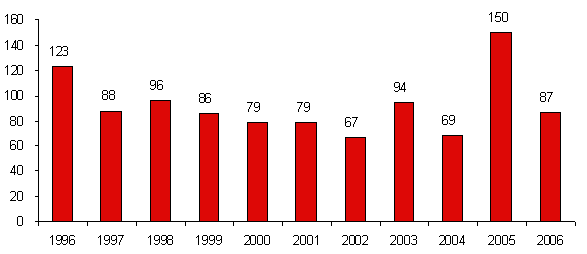 |
However, although the number of specialty jewelers who filed for bankruptcy declined significantly in 2006, the average claim that creditors placed against specialty jewelers in the U.S. continued to rise, and hit a record level of $6,546 in 2006, up more than 11 percent from the prior year.
The graph below summarizes the size of the average claim placed against U.S. specialty jewelers by creditors who use the Jewelers Board of Trade as their collection agent.
Average Claim Size Against Retail Jewelers
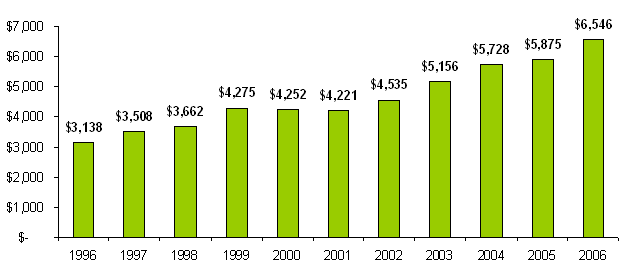 |
Source: US Jewelers Board of Trade
U.S. Jewelry Wholesalers Decline in 2006
The number of jewelry wholesalers in the U.S. declined again in 2006, and stands at its lowest level since the beginning of the decade. The number of jewelry wholesalers operating in the U.S. is up and down; in part, this is due to the ease of entry into the wholesale business. Typically, jewelry wholesalers have a modest office and some inventory; they don’t invest in production facilities, nor do they have any retail outlets. Many are nothing more than traveling sales people who operate from their homes. Thus, when jewelry demand is strong, the number of wholesalers typically rises; when demand cools, some of those wholesalers simply go out of business and vanish.
The graph below shows the trend of jewelry wholesale businesses in the U.S., as reported by the Jewelers Board of Trade.
U.S. Jewelry Wholesalers
 |
Source: US Jewelers Board of Trade
U.S. Jewelry Manufacturers Declining
For the past decade, the number of U.S. jewelry manufacturing businesses has been on a relentless decline. This is no surprise. Many manufacturers have moved their production operations offshore to countries where labor rates are much lower. IDEX Online Research believes that the number of manufacturers who actually have significant production facilities remaining in the U.S. is far fewer than shown by the Jewelers Board of Trade numbers. Many of the manufacturers shown in the JBT census may have corporate offices in the continental U.S., but no longer have any production facilities in the country.
The following graph illustrates the steady decline of jewelry manufacturers in the U.S.
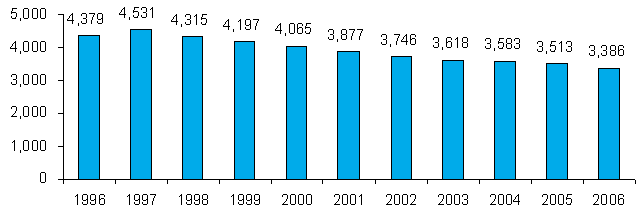 |
Source: US Jewelers Board of Trade
Outlook: More Specialty Jewelers To Fail in 2007
Based on historical trends and other research, IDEX Online Research believes that the net number of specialty jewelers closing their stores in 2007 could reach 800 or more. This implies a store-closing rate of about 1,100, with a store opening rate of 300 or so.
- Industry Consolidation – The U.S. jewelry industry is one of the last unconsolidated retail sectors. Unfortunately, it appears that retail consolidation is inevitable. It is difficult to find a retail sector that has escaped consolidation. Even retail categories that offer a high level of personal service – hair stylists, for example – are undergoing consolidation.
The graph below summarizes the market share of the top four merchants in selected retail categories compared with the market share of the top four jewelers. IDEX Online Research believes that the top jewelers – including Zale, Sterling, and others – will continue to capture market share as the industry consolidates.
Market Share of Top Four Merchants
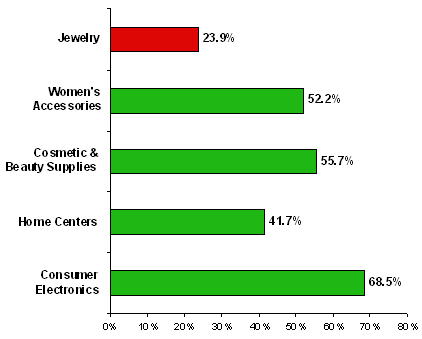 |
Source: US Dept of Commerce
For much of the past ten years, chain jewelers have been pushing independents out of business. However, except for Sterling Jewelers (Kay, Jared, and regionals such as J.B. Robinson), many of the chain jewelers in America have slowed their new store expansion plans. IDEX Online Research believes that, even without the push of chains, mom-and-pop jewelers are finding it more difficult to operate when competing against a whole new category of retailers who are selling jewelry – Wal-Mart, Kohl’s, Sears, and others. Based on the latest census figures, specialty jewelers’ sales represent only about 47 to 48 percent of total jewelry sales in America, a proportion that has been steadily declining. Further, mom-and-pop jewelers are burdened more than ever by government regulations (zoning, etc.). Finally, single-store independents cannot buy jewelry as efficiently as a chain jeweler; therefore, their merchandise offerings are typically not as competitive.
- Economic Pressure – When the economy of the U.S. is hot, the net number of jewelers closing their stores declines. When the economy slows, jewelry demand falls, and the marginal merchants are forced out of business. The graph below illustrates the correlation between the change in the net number of jewelry store closings and U.S. Gross Domestic Product (GDP).
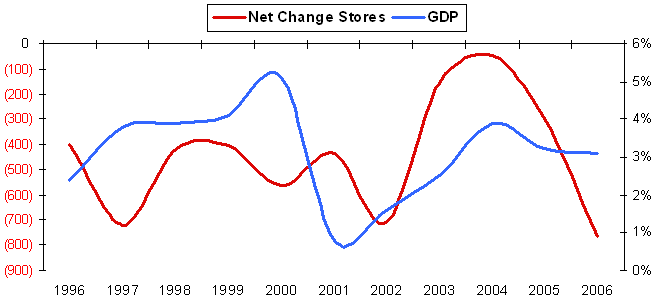 |
Source: US Dept of Commerce, Jewelers Board of Trade, and IDEX online
- Online Jewelry Merchants – Three years ago, we would not have mentioned online jewelry merchants as a threat to U.S. specialty jewelers. However, today, online jewelers have captured an estimated 3.9 percent market share of the total U.S. jewelry market, far ahead of most other retail categories. Of aggregate U.S. retail sales (all categories), only about 2.6 percent of sales are made online. Thus, online jewelry merchants have far more market share than online merchants in most other retail categories. Online jewelry merchants represent two threats to store-based jewelers: 1) lower prices; and 2) a new economic operating model. Online retailers such as Blue Nile sell diamonds less expensively than most store-based jeweler; young, Internet-savvy consumers know how to find the best prices online. Further, online jewelers’ financial models are much more efficient, with higher inventory turns, negative working capital, and low (or no) debt. Until store-based jewelers begin to adopt some of the components of the online economic operating model, they will be operating at a competitive disadvantage.
Percent of Total U.S. Jewelry Sales
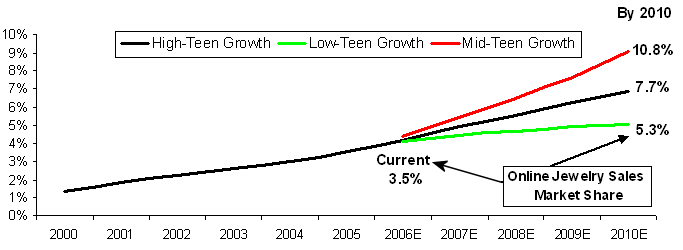 |
Source: US Dept of Commerce & JIRI
